
ABSTRACT
Little information exists on physiological consequences when wild fish eat natural food. Staghorn sculpins at 10–13°C voluntarily consumed 15.8% of their body mass in anchovies. Gastric clearance was slow with >60% of the meal retained in the stomach at 48 h, and was not complete until 84 h. At 14–24 h post-feeding, pH was depressed by 3 units and Cl− concentration was elevated 2-fold in gastric chyme, reflecting HCl secretion, while in all sections of the intestine, pH declined by 1 pH unit but Cl− concentration remained unchanged. PCO2 and total ammonia concentration were greatly elevated throughout the tract, whereas PNH3 and HCO3− concentration were depressed. Intestinal HCO3− secretion rates, measured in gut sacs in vitro, were also lower in fed fish. Whole-animal O2 consumption rate was elevated approximately 2-fold for 72 h post-feeding, reflecting ‘specific dynamic action’, whereas ammonia and urea-N excretion rates were elevated about 5-fold. Arterial blood exhibited a modest ‘alkaline tide’ for about 48 h, but there was negligible excretion of metabolic base to the external seawater. PaCO2 and PaO2 remained unchanged. Plasma total amino acid concentration and total lipid concentration were elevated about 1.5-fold for at least 48 h, whereas small increases in plasma total ammonia concentration, PNH3 and urea-N concentration were quickly attenuated. Plasma glucose concentration remained unchanged. We conclude that despite the very large meal, slow processing with high efficiency minimizes internal physiological disturbances. This differs greatly from the picture provided by previous studies on aquacultured species using synthetic diets and/or force-feeding. Questions remain about the role of the gastro-intestinal microbiome in nitrogen and acid–base metabolism.